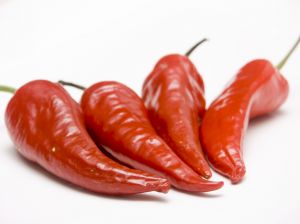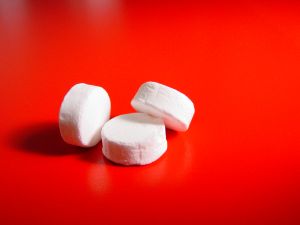If you eat a chilled chilli pepper, will it: a) Burn your mouth until you beg for mercy from unknown gods? b) Punish you with a brief case of freezer head (ice-cream headache)? c) Feel neither hot nor a cold as the cool temperature might balance out the natural 'heat' of the pepper?
If you aren't brave enough to undertake the research this question might entail, try a more delicious one instead - pop a mint in the microwave for a few seconds, then pop it in your mouth. The mint normally feels 'cool'. Will it still do so if the mint is warm?
 The heat of a pepper and the iciness of a mint are no psychological freak accidents. They are real sensations with similar underlying biochemical causes. Different pieces of information from the 'outside' world create different electrical patterns in our brains. For instance, heat causes the same electrical pattern in our brains each time, so when our brains receive this hallmark pattern, they know to say, 'Oh. Hot. Don't touch.' Cool temperatures create a different pattern, so when we touch something cold, our brains go, 'Oh. Not hot. Cold.' Our brains can get a bit confused though if, say, something like a mint produces the same pattern as cold. We might know that in fact we have just started chomping away on a piece of chewing gum because we put it there ourselves, but our brains tell us, 'Gum. Is. Cold.' (My brain, at least, speaks in halting monosyllables - perhaps my readers' brains are more sophisticated.)
The heat of a pepper and the iciness of a mint are no psychological freak accidents. They are real sensations with similar underlying biochemical causes. Different pieces of information from the 'outside' world create different electrical patterns in our brains. For instance, heat causes the same electrical pattern in our brains each time, so when our brains receive this hallmark pattern, they know to say, 'Oh. Hot. Don't touch.' Cool temperatures create a different pattern, so when we touch something cold, our brains go, 'Oh. Not hot. Cold.' Our brains can get a bit confused though if, say, something like a mint produces the same pattern as cold. We might know that in fact we have just started chomping away on a piece of chewing gum because we put it there ourselves, but our brains tell us, 'Gum. Is. Cold.' (My brain, at least, speaks in halting monosyllables - perhaps my readers' brains are more sophisticated.)
So how do chillis and mints produce the same electrical patterns in our brains that are also brought about by changes in temperature? One way of producing electrical impulses is by allowing ions (electrically charged atoms) to enter a cell by opening a gateway (or 'channel') in the cell membrane, changing the electrical charge within the cell with all sorts of interesting and complicated consequences. Capsaicin - the 'hot' molecule in chilli peppers - alters an 'ion channel' on nerve cells called TRP-V1, that is activated by 'hot' temperatures, causing an electrical change within the cells. Menthol in mints interacts with the same molecule (the TRP-M8 ion channel) on nerve cells that signals cool temperatures. The same pattern will be formed when the channels are opened, regardless of whether temperature change or taste causes it to open, and thus our brains are tricked into perceiving the 'wrong' sensation.
 Back to the original question then: If you simultaneously feed your brain opposing electrical patterns, how can it distinguish between the two? Obviously, this is an extremely complex issue which scientists are desperately trying to unravel with much broader applicability than the somewhat facile question I put forward. In short, how and when do we become confused? And how does accessory information - such as knowing there is a mint in your mouth - direct us in our actions?
Back to the original question then: If you simultaneously feed your brain opposing electrical patterns, how can it distinguish between the two? Obviously, this is an extremely complex issue which scientists are desperately trying to unravel with much broader applicability than the somewhat facile question I put forward. In short, how and when do we become confused? And how does accessory information - such as knowing there is a mint in your mouth - direct us in our actions?
In this particular scenario, it all might depend on whether or not these TRP molecules are found on the same neurones. If the neurones our chilled chilli pepper touches only possess TRP-V1, it will detect the heat but will be unable to respond to the cool temperatures. If the nerve cell expresses both TRP-V1 and TRP-M8 ion channels, then the situation might become confusing for the brain. But as yet, the data about whether the two molecules co-exist on the same cells remains unclear. As a final note, work on these two ion channels, and molecules like them, have further implications for understanding pain and deriving therapeutics. Menthol-containing creams, for instance, can be very good at relieving muscle aches at the same time as acting as an air freshener! Certain types of pain have also been shown to stimulate heat-sensing molecules in the TRP family, which could also explain why your brain can be confused into thinking, 'Vin. Da. Loo. Bad. Pain.' when really it is just a hearty curry well-endowed with hot spices.










Comments
Add a comment